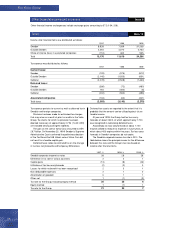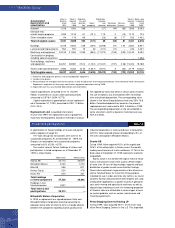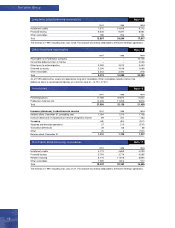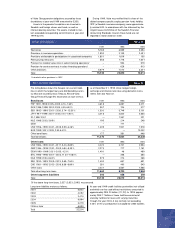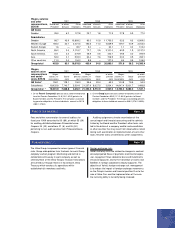Volvo 1999 Annual Report Download - page 75
Download and view the complete annual report
Please find page 75 of the 1999 Volvo annual report below. You can navigate through the pages in the report by either clicking on the pages listed below, or by using the keyword search tool below to find specific information within the annual report.
73
Other items not affecting cash pertain to capital gains on
the sale of subsidiaries and other business units, –26,900
(–366; –), risk provisions and losses related to doubtful
receivables and sales-financing receivables 766 (526;
704) and other 17 (–186; –60).
Net investments in sales-financing receivables result-
ed in 1999 in a negative cash flow of SEK 7.1 billion.
In this respect, liquid funds were reduced by SEK 14.2
billion pertaining to new investments in financial leasing
contracts and installment contracts.
Net investments in shares and participations during
1999 of SEK 25.9 billion pertained in entirety to future
investments, of which the acquisition of shares in Scania
AB and Mitsubishi Motors Corporation amounted to SEK
23.0 billion and SEK 2.3 billion, respectively. During
1998, changes in the Group’s shareholdings resulted in
a positive cash flow of SEK 5.5 billion, of which the sale
of shares, mainly Pharmacia & Upjohn Inc., contributed
SEK 6.9 billion, while investments in shares reduced
liquid funds by SEK 1.4 billion. During 1997, SEK 10.9
billion was added to liquid funds through the sale of
shares, mainly in Renault SA and Pripps Ringnes AB,
while investments in shares resulted in a negative cash
flow of SEK 0.2 billion.
Net investments during the year in loans to external
parties amounted to SEK 3.2 billion, of which SEK 2.0
billion pertained to payment of the convertible debenture
loan in Henlys group and SEK 1.3 billion new investment
in corporate bonds.
The change during the year in bonds and other loans
generated liquid funds of SEK 16.3 billion. New borrow-
ing during the year, mainly the issue of bond loans, pro-
vided SEK 19 billion, while settlement of the balance
with Volvo Cars provided SEK 20 billion. Amortization
during the year amounted to SEK 23 billion, most of
which pertained to loans related to Volvo Cars and
operations in South America.
In accordance with a resolution adopted at the Annual
General Meeting, the fee paid to the Board of Directors
is a fixed amount of SEK 2,475,000, to be distributed as
decided by the Board. The Chairman of the Board, Lars
Ramqvist, receives a fee of SEK 850,000.
In 1999, Leif Johansson, President and Chief
Executive Officer, received 8,192,520 in salary and other
benefits amounting to SEK 490,847. The bonus in 1998
was SEK 1,559,639 after deduction for the option
amount. This bonus, including a 6% upward adjustment,
a total of SEK 1,653,717 was allocated to pension. Leif
Johansson received 5,045 options at a value totaling
SEK 346,586. In addition, SEK 263,305 was paid
during the year in cash, consisting of a deferred bonus
from fiscal year 1997. For 1999 the bonus is a maxi-
mum of 30% of the annual salary. Leif Johansson is
eligible to take retirement with pension at age 55.
Pension benefits are earned gradually over the years
up to the employee’s retirement age and is fully earned
at age 55. During the period between the ages of 55
and 65, he would receive a pension equal to 70% of his
pension-qualifying salary, and a pension amounting to
50% of his pension-qualifying salary after reaching the
age of 65. Leif Johansson has a twelve months notice of
termination from AB Volvo and six months on his own
initiative. If Leif Johansson’s employment is terminated
by AB Volvo, he is entitled to a severance payment equal
to two years’ salary, plus bonus.
In 1999, Sören Gyll, President and Chief Executive
Officer up to and including April 22, 1997, received SEK
325,000 in board fees and other benefits amounting to
SEK 127,059. Sören Gyll continued to serve the Group
until December 31, 1997 and then retired on pension.
The Group Executive Committee, members of the
executive committees of subsidiaries and a number of
key executives receive bonuses in addition to salaries.
Bonuses are based on the performance of the Volvo
Group and/ or of the executive’s company, in accordance
with the bonus system established by the Volvo Board in
1993 and revised in 1996, 1997 and 1998. A bonus
may, in principle, amount to a maximum of 50% of an
executive’s annual salary.
The employment contracts of certain senior execu-
tives contain provisions for severance payments when
employment is terminated by the Company, as well as
rules governing pension payments to executives who
take early retirement. The rules governing early retire-
ment provide that, when employment is terminated by
the Company, an employee is entitled to severance pay
equal to the employee’s monthly salary for a period of 12
or 24 months, depending on age at date of severance. In
certain contracts, replacing contracts concluded earlier,
an employee is entitled to severance payments amount-
ing to the employee’s monthly salary for a period of 30
to 42 months. In agreements concluded after the spring
of 1993, severance pay is reduced, in the event the
Cash flow Note 28
At December 31, 1999, future rental income from non-
cancellable financial and operating leases (minimum
leasing fees) amounted to 19,910 (27,272; 19,991),
of which 19,383 (26,670; 19,322) pertains to sales-
financing companies. Future rental income is distributed
as follows:
Financial leases Operating leases
2000 3,848 2,787
2001–2004 7,907 5,029
2005 or later 208 131
Total 11,963 7,947
At December 31, 1999, future rental payments related
to noncancellable leases amounted to 5,328 (7,042;
6,356). Rental expenses in 1999 amounted to 1,193
(1,826; 2,002).
Future rental payments are distributed as follows:
Financial leases Operating leases
2000 613 1,181
2001–2004 1,021 2,261
2005 or later 91 161
Total 1,725 3,603
Leasing Note 29
Personnel Note 30



